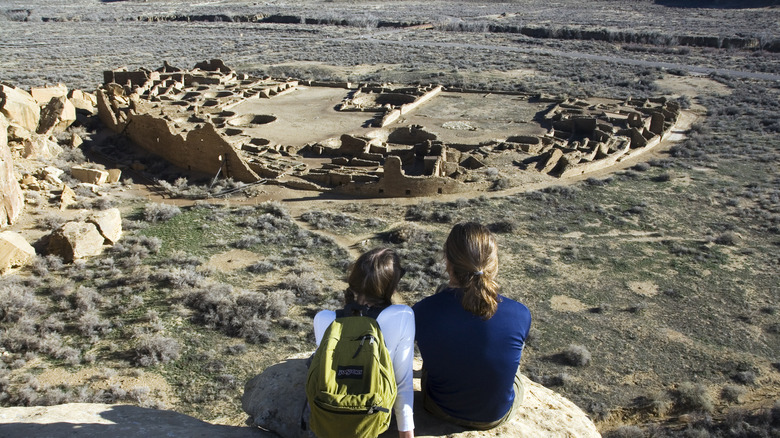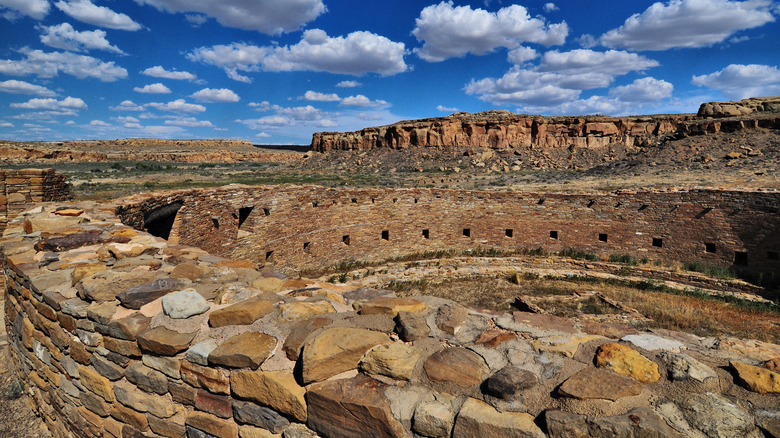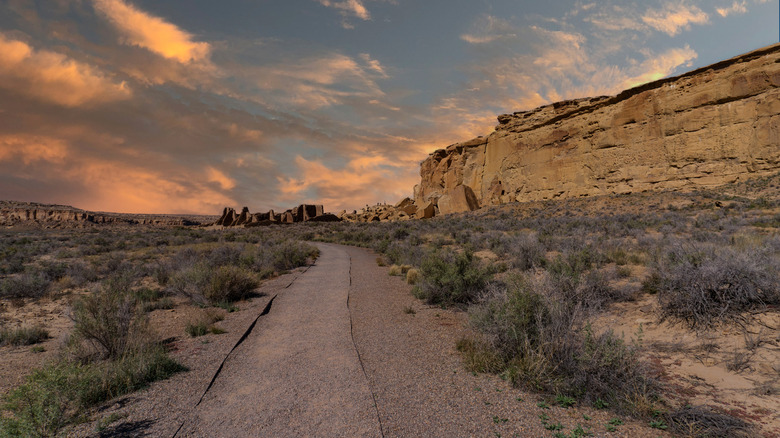The Striking Ruins In This Remote Southwest Canyon Were Once The Largest Buildings In North America
Many states across the U.S. are enchanting in their own ways, but only one state earns the label of America's official "Land of Enchantment." Though New Mexico doesn't get quite the tourism attention of its neighboring states of Texas, Colorado, and Arizona, this Southwestern gem has some of the most underrated attractions west of the Mississippi River. From natural wonders like Carlsbad Caverns to historical sites like the Taos Pueblo, and even fun novelties like a unique UFO-themed McDonald's in the cosmically charming city of Roswell, New Mexico has something for everyone. One of the state's lesser-known, but unmissable, treasures is tucked away in a National Park Service site about a three-hour drive north of Albuquerque. While Chaco Culture National Historical Park looks mostly like a beautiful, but undeveloped, desert canyon today, this magical landscape once held one of the largest cities in North America!
In terms of purely natural resources, Chaco Culture National Historical Park is a wonderful display of the strange, rugged beauty of New Mexico's Colorado Plateau. The park lies within a scenic canyon setting, carved by periodic rivers that wash through the harsh New Mexican landscape. But this canyon protects one of America's most important archeological sites. Centuries before European colonization, Chaco Canyon was home to a major urban area and some of the largest buildings in North America at the time. Today, Chaco Canyon serves as an essential preserve of the culture and history of the region's Native American civilizations, while offering some of New Mexico's best, scenic hikes.
Chaco Canyon has some of North America's greatest archeological treasures
Chaco Canyon lies within the semi-arid Colorado Plateau, near the Four Corners region. The landscape features many classic shots of the American West, including desert plains, towering mesas, and deep canyon cliffs. Though the canyon looks desolate at first, its network of "arroyos" (i.e. periodic rivers that flow through natural gullies) has created an "'island' of biodiversity" in the desert ecosystem, according to the National Park Service. The protective walls of the canyon, combined with this richness of plant and animal life, made the region the perfect place for ancient peoples to build their cities.
Beginning around the year 850 CE, a pre-Columbian civilization known as the Ancestral Puebloans built large, intricate structures throughout Chaco Canyon. The Ancestral Puebloans built many long-lasting architectural masterpieces across the Southwest, including the cliff dwellings at Colorado's underrated archeological wonder of Mesa Verde National Park. But the Chaco Canyon Pueblo likely contains the largest structures ever built by an Ancestral Puebloan culture. Many of these "great houses" rose to several stories in height, and sometimes contained hundreds of rooms. At its peak around 1050 CE, the Chacoan Culture Pueblo was likely the political, cultural, and economic center of the entire region.
Today, Chaco Culture National Historical Park lets you explore the preserved ruins of this once-thriving city center, with close access to many of its most impressive buildings. The park's Pueblo Bonito is the epicenter of the entire archeological complex. Following its completion around 1150 CE, Pueblo Bonito may have been the largest building in North America! Other preserved Chaco Culture structures like Chetro Ketl, Hungo Pavi, and Una Vida showcase the architectural genius of the Ancestral Puebloans, while the park's Petroglyph Trail preserves their unique artwork still etched into the rocks.
Chaco Culture National Historical Park is one of the Southwest's best destinations
The Chaco Culture ruins tell us much about this remarkable civilization, but even today, scientists are still uncovering the city's secrets. Chaco Culture National Historical Park has been the site of many major archeological breakthroughs, ranging from insights into the Ancestral Puebloans' astronomical knowledge to the discovery of one of the earliest forms of chocolate! The park's archeological treasures and stunning surrounding landscape also make it one of New Mexico's best places for hiking. Each of the park's main houses is accessible via a well-marked and generally short trail. Though the park has implemented reasonable restrictions to protect the fragile structures, you can still get close enough to experience these one-of-a-kind archeological icons up close. You can also explore the deeper wilderness around the archeological sites on the park's four backcountry trails. Additionally, many of the park's trails are also great for biking!
Though Chaco Culture National Historical Park is fairly remote, it does make an excellent destination for a road trip. Two and a half hours away, New Mexico's Bandelier National Monument is an "open book of human history" with scenic canyons, mesas, and ancient petroglyphs. Chaco Culture is also a major stop on the Trail of the Ancients Scenic Byway, a lengthy route through the Four Corners region that stops at other major archeological and cultural sites of the Ancestral Puebloan, Navajo, Ute, and Apache peoples. Chaco Culture's Gallo Campground has both tent and RV campsites for $20 per night for individual sites or $60 per night for group camping. These campsites let you sleep right next to the park's magnificent ancient buildings! As an International Dark Sky Park, Chaco Culture's overnight campground lets you see the same unblemished night skies that the stargazing Ancestral Puebloans saw centuries ago!


